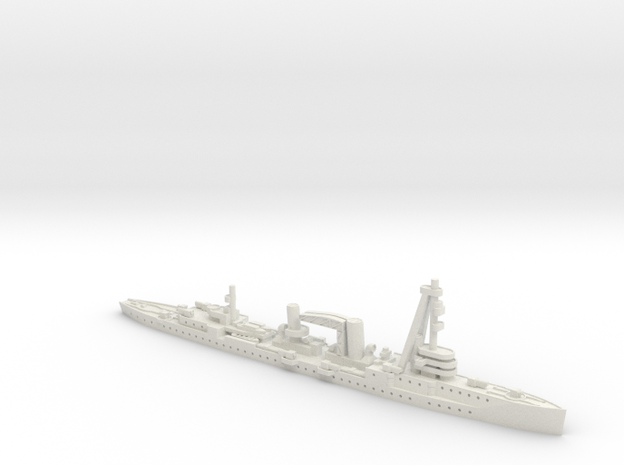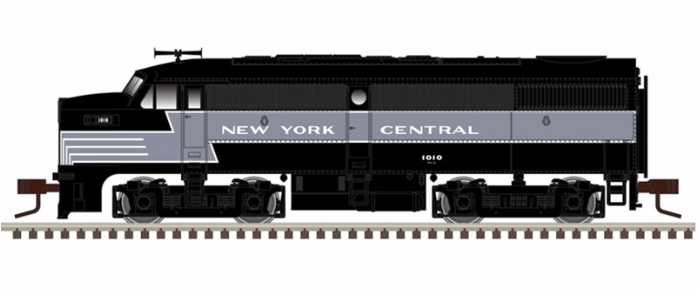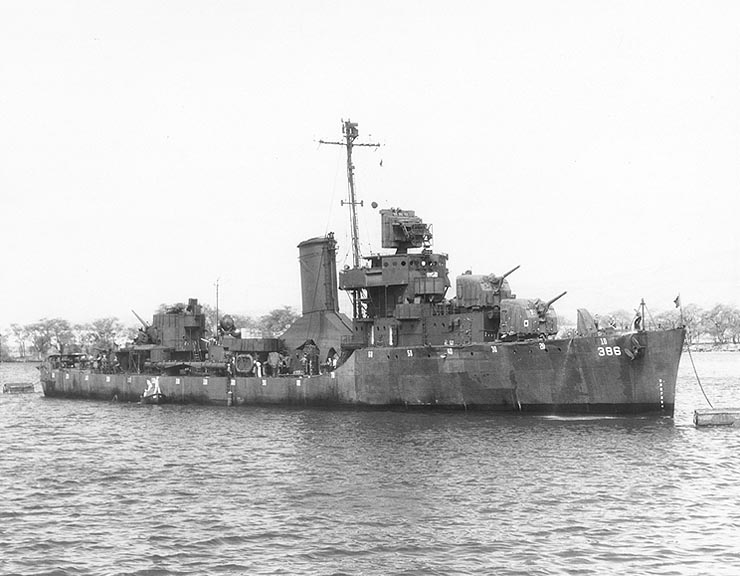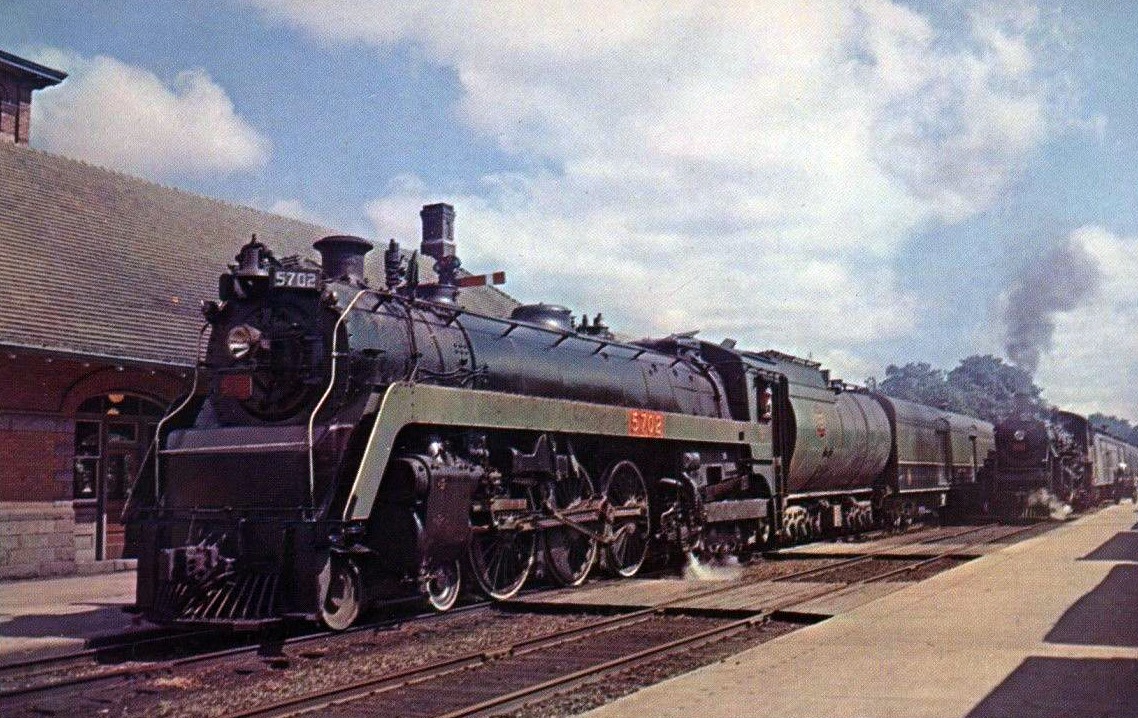Model Information: From 1969 to 1994 this model was made for Con-Cor by Kato under contract. The early Katos were a bit sketchy, but they were extensively re-designed in 1975 and the newer version runs a lot better. While not of the same caliber as Kato's later 2-8-2 Mikado, this 1975 steam engine engine is nevertheless an impressive model, much better than its contemporaries from Lima and Rivarossi. In 1994, Con-Cor started production of a new model in China that is of similar quality to the 1975 Kato model and also runs quite well. The Kato-made models are stamped 'Con-Cor Japan' on the bottom.
Prototype History: Under the Whyte notation for the classification of steam locomotives, 4-6-4 represents the wheel arrangement of four leading wheels, six powered and coupled driving wheels and four trailing wheels. In France where the type was first used, it is known as the Baltic while it became known as the Hudson in most of North America.
The 4-6-4 tender locomotive was first introduced in 1911 and throughout the 1920s to 1940s, the wheel arrangement was widely used in North America and to a lesser extent in the rest of the world. The type combined the basic design principles of the 4-6-2 Pacific type with an improved boiler and larger firebox that necessitated additional support at the rear of the locomotive. In general, the available tractive effort differed little from that of the Pacific, but the steam-raising ability was increased, giving more power at speed. The 4-6-4 was best suited to high-speed running across flat terrain. Since the type had fewer driving wheels than carrying wheels, a smaller percentage of the locomotive's weight contributed to traction, compared to other types. Like the Pacific, it was well suited for high speed passenger trains, but not for starting heavy freight trains and slogging on long sustained grades, where more pairs of driving wheels are better.
The first 4-6-4 in the United States of America, the J-1 of the New York Central Railroad, was built in 1927 to the railroad’s design by the American Locomotive Company (ALCO). There, the type was named the Hudson after the Hudson River.
From Wikipedia
The 4-6-4 tender locomotive was first introduced in 1911 and throughout the 1920s to 1940s, the wheel arrangement was widely used in North America and to a lesser extent in the rest of the world. The type combined the basic design principles of the 4-6-2 Pacific type with an improved boiler and larger firebox that necessitated additional support at the rear of the locomotive. In general, the available tractive effort differed little from that of the Pacific, but the steam-raising ability was increased, giving more power at speed. The 4-6-4 was best suited to high-speed running across flat terrain. Since the type had fewer driving wheels than carrying wheels, a smaller percentage of the locomotive's weight contributed to traction, compared to other types. Like the Pacific, it was well suited for high speed passenger trains, but not for starting heavy freight trains and slogging on long sustained grades, where more pairs of driving wheels are better.
The first 4-6-4 in the United States of America, the J-1 of the New York Central Railroad, was built in 1927 to the railroad’s design by the American Locomotive Company (ALCO). There, the type was named the Hudson after the Hudson River.
From Wikipedia
Road Name History: The New York Central Railroad (reporting mark NYC), known simply as the New York Central in its publicity, was a railroad operating in the Northeastern United States. Headquartered in New York City, the railroad served most of the Northeast, including extensive trackage in the states of New York, Pennsylvania, Ohio, Michigan, Indiana, Illinois, and Massachusetts, plus additional trackage in the Canadian provinces of Ontario and Quebec.
The railroad primarily connected greater New York and Boston in the east with Chicago and St.Louis in the midwest along with the intermediate cities of Albany, Buffalo, Cleveland, Cincinnati, and Detroit. NYC's Grand Central Terminal in New York City is one of its best known extant landmarks.
1853 company formation: Albany industrialist and Mohawk Valley Railroad owner Erastus Corning managed to unite ten railroads together into one system, and on March 17, 1853 executives and stockholders of each company agreed to merge. The merger was approved by the state legislature on April 2, and by May 17, 1853 the New York Central Railroad was formed.
In 1867 Vanderbilt acquired control of the Albany to Buffalo running NYC. On November 1, 1869 he merged the NYC with his Hudson River Railroad into the New York Central and Hudson River Railroad. Vanderbilt's other lines were operated as part of the NYC.
In 1914, the operations of eleven subsidiaries were merged with the New York Central & Hudson River Railroad, re-forming the New York Central Railroad. From the beginning of the merge, the railroad was publicly referred to as the New York Central Lines. In the summer of 1935, the identification was changed to the New York Central System.
In 1968 the NYC merged with its former rival, the Pennsylvania Railroad, to form Penn Central (the New York, New Haven and Hartford Railroad joined in 1969). That company went bankrupt in 1970 and was taken over by the federal government and merged into Conrail in 1976. Conrail was broken up in 1998, and portions of its system was transferred to the newly formed New York Central Lines LLC, a subsidiary leased to and eventually absorbed by CSX and Norfolk Southern. Those companies' lines included the original New York Central main line, but outside that area it included lines that were never part of the New York Central system. CSX was able to take one of the most important main lines in the nation, which runs from New York City and Boston to Cleveland, Ohio, as part of the Water Level Route, while Norfolk Southern gained the Cleveland, Ohio to Chicago, Illinois portion of the line called the Chicago line.
At the end of 1925, the New York Central System operated 11,584 miles (18,643 km) of road and 26,395 miles (42,479 km) of track; at the end of 1967 the mileages were 9,696 miles (15,604 km) and 18,454 miles (29,699 km).
Read more on Wikipedia.
The railroad primarily connected greater New York and Boston in the east with Chicago and St.Louis in the midwest along with the intermediate cities of Albany, Buffalo, Cleveland, Cincinnati, and Detroit. NYC's Grand Central Terminal in New York City is one of its best known extant landmarks.
1853 company formation: Albany industrialist and Mohawk Valley Railroad owner Erastus Corning managed to unite ten railroads together into one system, and on March 17, 1853 executives and stockholders of each company agreed to merge. The merger was approved by the state legislature on April 2, and by May 17, 1853 the New York Central Railroad was formed.
In 1867 Vanderbilt acquired control of the Albany to Buffalo running NYC. On November 1, 1869 he merged the NYC with his Hudson River Railroad into the New York Central and Hudson River Railroad. Vanderbilt's other lines were operated as part of the NYC.
In 1914, the operations of eleven subsidiaries were merged with the New York Central & Hudson River Railroad, re-forming the New York Central Railroad. From the beginning of the merge, the railroad was publicly referred to as the New York Central Lines. In the summer of 1935, the identification was changed to the New York Central System.
In 1968 the NYC merged with its former rival, the Pennsylvania Railroad, to form Penn Central (the New York, New Haven and Hartford Railroad joined in 1969). That company went bankrupt in 1970 and was taken over by the federal government and merged into Conrail in 1976. Conrail was broken up in 1998, and portions of its system was transferred to the newly formed New York Central Lines LLC, a subsidiary leased to and eventually absorbed by CSX and Norfolk Southern. Those companies' lines included the original New York Central main line, but outside that area it included lines that were never part of the New York Central system. CSX was able to take one of the most important main lines in the nation, which runs from New York City and Boston to Cleveland, Ohio, as part of the Water Level Route, while Norfolk Southern gained the Cleveland, Ohio to Chicago, Illinois portion of the line called the Chicago line.
At the end of 1925, the New York Central System operated 11,584 miles (18,643 km) of road and 26,395 miles (42,479 km) of track; at the end of 1967 the mileages were 9,696 miles (15,604 km) and 18,454 miles (29,699 km).
Read more on Wikipedia.
Brand/Importer Information: Con-Cor has been in business since 1962. Many things have changed over time as originally they were a complete manufacturing operation in the USA and at one time had upwards of 45 employees. They not only designed the models,but they also built their own molds, did injection molding, painting, printing and packaging on their models.
Currently, most of their manufacturing has been moved overseas and now they import 90% of their products as totally finished goods, or in finished components. They only do some incidental manufacturing today within the USA.
Important Note: The Con-Cor product numbering can be very confusing. Please see here in the article how to properly enter Con-Cor stock numbers in the TroveStar database.
Currently, most of their manufacturing has been moved overseas and now they import 90% of their products as totally finished goods, or in finished components. They only do some incidental manufacturing today within the USA.
Important Note: The Con-Cor product numbering can be very confusing. Please see here in the article how to properly enter Con-Cor stock numbers in the TroveStar database.
Item created by: gdm on 2016-07-28 05:11:16. Last edited by Alain LM on 2020-11-22 11:02:56
If you see errors or missing data in this entry, please feel free to log in and edit it. Anyone with a Gmail account can log in instantly.
If you see errors or missing data in this entry, please feel free to log in and edit it. Anyone with a Gmail account can log in instantly.











